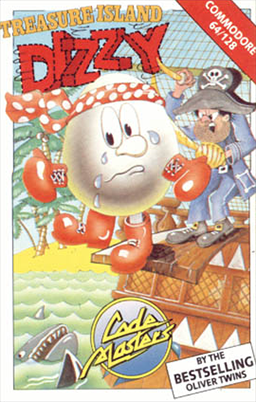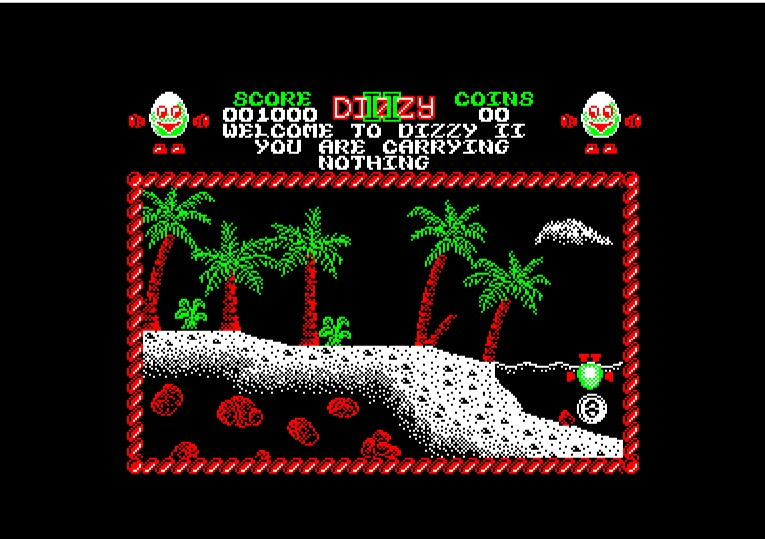Week 3: Challenge Activity!
- Will Ward
- Oct 8, 2020
- 4 min read
This week’s challenge activity was to identify an artefact that you find interesting, which could be anything from an inventory system to a website that uses AR or VR and then choose one or two prototyping methods high-lighted from this week’s recommended reading to build a quick prototype representation of the artefact by reverse engineering it.
To complete this challenge, I’ve decided to go back to my first computer, the Amstrad CPC and an 8-bit Legend!

That’s right, I’ve chosen Dizzy, or more specifically Treasure Island Dizzy, which was developed by the Oliver Twins and published by Codemasters all the way back in 1988.
Treasure Island Dizzy had some distinct differences from the original Dizzy which included an updated inventory system, improved animations, scarcer enemies and gameplay more focussed on inventory management.
The aim of the game is to solve a variety of puzzles in order leave the aforementioned treasure island*. To do this the player must guide Dizzy through numerous locations, such as, haunted mines, tree villages, rocky beaches and the ocean.
*This can only be achieved by completing the game’s side quest of collecting thirty gold coins, which are liberally scattered (and hidden) around the island’s many locations.
Treasure Island Dizzy, is widely considered to be the most difficult of all Dizzy games game due to giving the player only one life – which can be lost easily in a range of ways, such as; drowning, being caught in traps and getting to close to fire torches. All of which is left for the player to find out for themselves…
As mentioned before, the inventory management is unique to this iteration of Dizzy, as the player is unable to select any item from the inventory for use – it simply drops down whichever item is at the top. This could be particularly frustrating if the player wasn’t paying attention when Dizzy is underwater and the snorkel (needed to go underwater without dying) was at the top of the inventory - as the snorkel would be dropped when the player collects another item and instantly die.
This mechanic ensured that Treasure Island Dizzy required more concentration and planning than any of the other games in the Dizzy series. Finally, the game had a bit of a ‘gotcha’ moment at what the player believes is the end of the game, as after completing all of the puzzles to escape the player is then told that they need to collect all thirty coins before they can leave!
In order to complete this week’s challenge, I decided to visit the Oliver Twins website and look through some of the various media on their website: www.olivertwins.com for a bit of research. This included old press articles, adverts and photos and a very interesting insight into their career during the 80's and 90's. This then took me their YouTube channel (and I found a brief playthrough video of Treasure Island Dizzy on the ZX Spectrum (https://www.youtube.com/watch?v=OQ014u713Qs) which gave a great overview of their thought processes and reasoning for various gameplay elements like the inventory system and why the game only had one life.
Once I'd finished my research, I decided that I'd concentrate on the first few puzzles, along with the controls and inventory system. To do this, I played an emulated Amstrad CPC version on the http://www.yolkfolk.com/ website to refamiliarize myself with the game and then made a mind map to help me analyse the core gameplay mechanics and level design.
As a side note, whilst playing through and experimenting with the environment, it was interesting to note how (more) modern games really ease the player into a game with their gentle tutorial introductions that teach core gameplay mechanics within a safe ‘bubble’.
Whereas most games from the 8-bit era just throw the player in at the deep end – quite literally in Treasure Island Dizzy, you can lose on the first screen by just being to

curious*…
*This is particularly mean, as there is a coin in the water to deliberately lure the player!
Once I played through for a while, I made some initial sketches and diagrams to lay out the screen order for what I considered to be the first three puzzle elements, interactive objects, hazards and precision jumping areas. I mapped it out screen by screen using some rough sketched landmarks and platform layouts.

I then made a neater version with a proper key with colour so it was clearer, I also added colour to the the different environments on the island and to make it easier to visualise and labelled the various hazards.

I also revisited the start screen, player display, keyboard controls and the inventory system, with the last two elements being vital features of the gameplay experience.
The Inventory system was an interesting feature to try and plan on paper and I tried a little unsuccessfully to create a sort of flow chart to explain it and should have given it it's own sheet and more detail, as it wasn't very succinct.
Overall, I've really enjoyed this challenge, as it's allowed me to combine some of the creativity techniques from last week's challenge and revel in a bit of nostaglia. I found that I really enjoyed using sketching and diagram prototyping methods to backwards engineer Treasure Island Dizzy and found it very beneficial to understanding the original level design and how the interface challenges shaped it's gameplay.
References:
Oliver Twins. (n.d.). Home Page. [online] Available at: https://www.olivertwins.com/ [Accessed 8 Oct. 2020].
OliverTwins (2015). Let’s Play Treasure Island Dizzy by The Oliver Twins 1988. YouTube. Available at: https://www.youtube.com/watch?v=OQ014u713Qs [Accessed 8 Oct. 2020]. www.yolkfolk.com. (n.d.). The Dizzy Fansite. [online] Available at: http://www.yolkfolk.com/ [Accessed 8 Oct. 2020].


My brother had the Amstrad. I can remember Arcanoid and Rampage. Never tried Dizzy though. If I remember, at the time, games were on floppy disks, weren't they. You made me curious about that game and feel the nostalgia about the good old Amstrad. I shall see if those games are still on the market. Thanks.